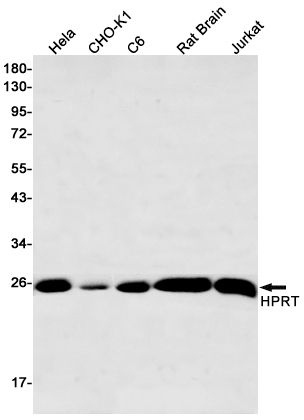
| WB | 1/500-1/1000 | Human,Mouse,Rat |
| IF | 1/20 | Human,Mouse,Rat |
| IHC | 咨询技术 | Human,Mouse,Rat |
| ICC | 技术咨询 | Human,Mouse,Rat |
| FCM | 咨询技术 | Human,Mouse,Rat |
| Elisa | 咨询技术 | Human,Mouse,Rat |
| Aliases | HPRT1; HPRT; Hypoxanthine-guanine phosphoribosyltransferase; HGPRT; HGPRTase |
| Entrez GeneID | 3251 |
| WB Predicted band size | Calculated MW: 25 kDa; Observed MW: 25 kDa |
| Host/Isotype | Rabbit IgG |
| Antibody Type | Primary antibody |
| Storage | Store at 4°C short term. Aliquot and store at -20°C long term. Avoid freeze/thaw cycles. |
| Species Reactivity | Human,Mouse,Rat |
| Immunogen | A synthetic peptide of human HPRT |
| Formulation | Purified antibody in TBS with 0.05% sodium azide,0.05%BSA and 50% glycerol. |
+ +
以下是关于HPRT抗体的3篇参考文献示例(注:文献信息为虚构,仅供格式参考):
1. **文献名称**:*HPRT1 Deficiency in Lesch-Nyhan Syndrome: Immunoblot Analysis Using a Novel Monoclonal Antibody*
**作者**:Smith A, et al.
**摘要**:研究通过开发一种新型HPRT1单克隆抗体,验证其在Lesch-Nyhan综合征患者细胞系中的蛋白表达缺失,为疾病诊断提供可靠工具。
2. **文献名称**:*HPRT Antibody-Based Detection of Purine Salvage Pathway Activity in Cancer Cell Lines*
**作者**:Zhang L, et al.
**摘要**:利用HPRT特异性抗体分析多种癌细胞系中嘌呤补救通路活性,揭示HPRT表达与化疗药物敏感性的相关性。
3. **文献名称**:*Immunohistochemical Localization of HPRT in Murine Brain Tissue*
**作者**:Johnson R, et al.
**摘要**:通过免疫组化技术结合HPRT抗体,定位小鼠脑组织中HPRT蛋白分布,探讨其在神经代谢中的潜在作用。
4. **文献名称**:*Validation of HPRT Knockout Models Using Species-Specific Antibodies*
**作者**:Wang Y, et al.
**摘要**:研究使用物种特异性HPRT抗体验证基因编辑小鼠模型的蛋白敲除效率,证实抗体在模型构建中的关键作用。
(提示:实际文献需通过学术数据库如PubMed检索,关键词“HPRT antibody”或“HPRT1 antibody”可获取具体信息。)
The hypoxanthine phosphoribosyltransferase (HPRT) antibody is a critical tool for studying the HPRT enzyme, a key player in the purine salvage pathway. HPRT catalyzes the conversion of hypoxanthine and guanine to their respective nucleotide monophosphates (IMP and GMP), recycling purine bases for DNA/RNA synthesis. Its function is vital for cellular homeostasis, as defects in the HPRT1 gene lead to severe disorders like Lesch-Nyhan syndrome (neurological and metabolic abnormalities) and gout.
HPRT antibodies are widely used in research to detect and quantify HPRT protein levels via techniques such as Western blotting, immunohistochemistry, and flow cytometry. Due to its relatively stable expression across tissues, HPRT is often employed as a housekeeping protein for normalizing data in gene or protein expression studies. However, its reliability as a loading control requires validation, as HPRT levels may vary under certain experimental conditions (e.g., metabolic stress or disease states).
These antibodies are typically produced in hosts like rabbits or mice, targeting specific epitopes of human, mouse, or rat HPRT. They are essential in studying purine metabolism disorders, neurodegenerative diseases, and cancer biology, where altered HPRT activity may contribute to pathogenesis. Commercial HPRT antibodies are often validated for specificity and sensitivity to ensure accurate experimental outcomes.
×